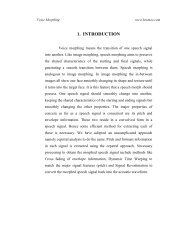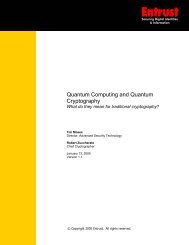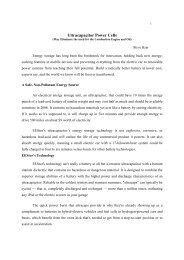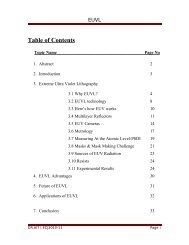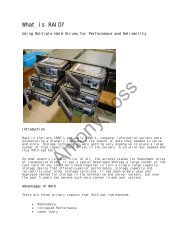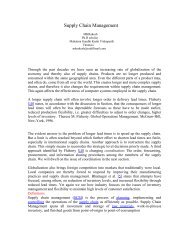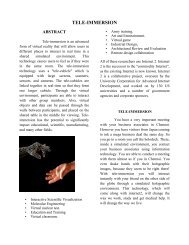Moletronics Full Paper.doc - 123SeminarsOnly
Moletronics Full Paper.doc - 123SeminarsOnly
Moletronics Full Paper.doc - 123SeminarsOnly
Create successful ePaper yourself
Turn your PDF publications into a flip-book with our unique Google optimized e-Paper software.
MOLETRONICS<br />
MANISH KR. PATHAK<br />
EC 3 rd Yr.(A1)<br />
0800131049
OVERVIEW<br />
►INTRODUCTION<br />
INTRODUCTION<br />
►WHAT WHAT IS MOLECULAR ELECTRONICS ???<br />
►HISTORY HISTORY<br />
►WHY WHY MOLECULAR ELECTRONICS ?????<br />
►OPERATION<br />
OPERATION<br />
►ROADBLOCKS<br />
ROADBLOCKS
MOORE’S LAW<br />
► The number of transistors that can be fabricated<br />
on a silicon integrated circuit and therefore the<br />
computing speed of such a circuit is doubling<br />
every 18 to 24 months.<br />
► After four decades, solid-state microelectronics<br />
has advanced to the point at which 100 million<br />
transistors, with feature size measuring 180 nm<br />
can be put onto a few square centimeters of<br />
silicon
INTRODUCTION<br />
Molecular Electronics is recognized as a<br />
key candidate to succeed the silicon based<br />
technology once we have arrived at the<br />
end of the semiconductor roadmap. The<br />
use of organic molecules in nanoscale<br />
nonlinear circuits offers many opportunities<br />
for new types of devices, which will differ in<br />
fabrication, functionality, and architecture
BASIC IDEA
MOLECTRONICS<br />
Molecular electronics involves the<br />
study and application of molecular<br />
building blocks for the fabrication of<br />
electronic components.<br />
It investigates the electronic transport<br />
and current flow at the molecular<br />
level.
HISTORY OF MOLETRONICS
► 1950s- 1950s-<br />
INVENTION OF TRANSISTOR<br />
► 1956- 1956-<br />
ARTHUR VON GAVE IDEA ABOUT<br />
MOLECULAR ENGINEERING<br />
► 1960s & 1970s- EXPERIMENTS ALL AROUND THE<br />
WORLD<br />
► 1981-”STM” 1981-”STM”<br />
INVENTED (FIRST TOOL TO<br />
PROVIDE ABILITY TO SEE AT ATOMIC<br />
LEVEL)
WHY MOLETRONICS<br />
►SMALLER SMALLER SIZE<br />
►NEW NEW FUNCTIONALITIES<br />
►POWER/ POWER/ SPEED<br />
►LOW LOW MANUFACTURING COST
SIZE<br />
►Molecular Molecular Electronics is a way to<br />
extend Moore’s Law past the limits of<br />
standard semiconductor Circuits.<br />
►100X 100X smaller than their counterparts
POWER/SPEED<br />
►Currently Currently Transistors cannot be stacked,<br />
which makes them quite ineffecient!<br />
►Molecular Molecular technology will be able to add a 3<br />
dimension.<br />
dimension<br />
►Femtoseconds<br />
Femtoseconds switching times.
MANUFACTURING<br />
►Most Most designs use either spin coating or<br />
Self-Assembly process.<br />
►Individual Individual Molecules can be made exactly<br />
the same by the Billions.<br />
►Molecular Molecular assembly tends to occur at Room<br />
Temperature.
MOLECULAR SWITCH<br />
►Semiconductor Semiconductor switches can be made on a<br />
very small scale.<br />
►Perform Perform computational functions when<br />
placed in the right combination.<br />
►Molecular Molecular switch is orders of magnitude<br />
smaller.
OPERATION<br />
►In In practice, the switch is triggered by<br />
light and controlled with an electric<br />
field.<br />
►Both Both of these actions can change the direction<br />
of the molecule’s dipole by 180 degrees.
MOLECULAR MATERIALS FOR<br />
ELECTRONICS<br />
►THIS THIS GENERALLY REFERS TO<br />
“CONDUCTING CONDUCTING POLYMERS”<br />
POLYMERS<br />
►CONDUCTING CONDUCTING POLYMERS ARE<br />
ORGANIC POLYMERS THAT CONDUCTS<br />
ELECTIRCITY IN BULK STATE (GOOD<br />
CONDUCTIVITY).
Eg. CONDUCTING POLMERS<br />
►POLYACTLENE<br />
POLYACTLENE<br />
►POLYTHIOPENE<br />
POLYTHIOPENE<br />
►POLYANILINE POLYANILINE etc.
FUTURE<br />
►SOONER SOONER Si BASED DEVICE WILL BE<br />
REPLACED BY THE MOLECULAR BASED<br />
ELECTRONIC DEVICES.
MOLETRONICS ROADBLOCKS<br />
► Molecular electronics must still be integrated with Silicon.<br />
► Among the important issues is the determination of the<br />
resistance of a single molecule (both theortical and<br />
experimental).<br />
► It is difficult to perform direct characterization since<br />
imaging at the molecular scale is often impossible in<br />
many experimental devices.<br />
► Interconnection of two components at molecular level




